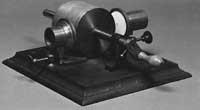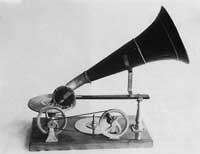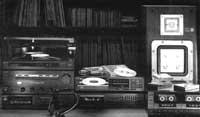Sound recording and playback
Sound produces vibrations that then produce sound. According to this phrase, it seems easy to record and reproduce the sound, however, throughout history there have been many headaches. They are clear exponents of that desire and impotence, both Chinese and Egyptian. They realized that sound produced vibrations, but from there they did nothing else. Scientists and writers dreamed for centuries of the apparatus that collected and reproduced sound.

In 1969, Cyrano de Bergerac dreamed of a machine of springs and multiple mechanisms that gave to the key of the apparatus and drew sounds in the dream, as it leaves the mouth of any or any instrument.
But it was Thomas Edison who discovered the mystery. For this he used his voice and the machine that his friend Kreisu designed. Finally, after several tests he managed to vibrate the diaphragm concentrating his voice in the horn. He tied a needle to Diaphragm and made it pass over a rotating cylinder with soft material surface: the vibration engraved grooves on the surface.
If it happened upside down, that is, if the line vibrated needle and diaphragm, the original sound would come out of the horn. After many attempts, in 1877 Edison could hear his voice: Part of the song “Mary had a little lamb”. His invention was baptized as a phonograph and patented in 1878.
Ten years later, German-born American Emile Berliner placed a flat plate on the record player, the phonograph. He could verify that this system was more convenient to make and use many copies. The renovated apparatus was called gramophone.
Edison invented the way to save and reproduce the sound, but the apps barely reached the market. The trade was the first to use the phonograph. The first commercial devices and discs appeared in Germany in 1889 and four years later in the United States.
In 1898 a telecommunications engineer, the Danish Valdemar Poulsen, managed to perform a magnetic recording. But he did not invent the tape recorder, but the telegraph, which replaced the tape with the wire. Although the magnetic recording was invented, the commercial discs would be made by acoustic process until 1925, when the first electric discs appeared. Microphones and amplifiers were also needed for electric recording, as simple sound is not enough. The first American film producer to replace wire with magnetic tape was Louis Blattner in 1920.

Ever since Edison's phonograph took the first step, recording and reproducing the sound became ever more quality. In 1948 microfiber discs were released, the stereophonic technique became known in 1958... and thus one innovation after another. More than one musician vanished, live acts were abandoned and tried to get money out of the sale of records.
To know the development of sound and, above all, of the recording and reproduction of music, we only have to look at the supports in which we listen to our most beloved songs. Records first, booths later. The first has almost disappeared. The second, with an increasingly reduced market, is full of compact discs. The latest innovation, already widespread and apparently comfortable, of good quality and less expensive.
We then review three well-known devices that launch discs, huts and compact discs.
Turntable
The record player plays the recorded sounds on the disc. The most important components are the disc drive or plate, amplifier and speakers. The rotating disc has a turning motor and a needle. Glued to the needle there is a magnet and when the walls of the disc line vibrate, the magnet also vibrates, creating electrical signals. The amplifier increases the intensity of these electric pulses. The speakers turn the electric current into a sound wave.
The discs are very simple. Both sides have almost invisible grooves. The record is placed on the turntable and the rotator begins to turn clockwise. The needle goes through the grooves, “reading” their remains and turning them into acoustic signals. These lines are so thin that in a radius centimeter one hundred lines are crossed on 33 or 45 rpm discs.
Microphone
The tape recorder is a device that records and reproduces sound by tape or magnetic stripe. The recording process is analogous. The name of magnetophone comes from a brand made by a German house. To reproduce sounds they performed a sound recorder called Magnetophon. From 1945 the manufacturer's brand became a common name for all similar appliances. The first ones are made of wire or steel tape, while the current ones use plastic tape coated with ferromagnetic powder.
The booth we enter in the magnetophone moves between three magnetic heads formed by electromagnets. A magnetic head eliminates all possible noises from the tape. The second head is used to record sounds and the third one plays the recorded. Some magnetophones have a single head that performs all three functions simultaneously, that is, they eliminate, record and reproduce noises.
The booth is only a plastic box with a magnetic tape inside. This tape is wrapped in two coils. When inserted into the tape recorder, the tape will pass from one coil to another, both during recording and during sound playback.
Compact disc

Compared to the record player, the compact disc playback device is based on the digital method. The compact disc has a spiral band and uses a binary code. The diameter of the disc is twelve centimeters. The band is thinner than the hair and has several kilometers in length. The disc rotates quickly, 500 revolutions per minute in the center and 200 per minute at the edges, maintaining a constant linear speed when passing through the optical reader. The function of the optical reader is to decode the bands. Through mirrors and lenses a laser beam is thrown under the disc, the spiral band.
When the disc rotates, the laser beam moves from center to edge. The laser beam produces encoded signals (type 0 and type 1) that become stereophonic electrical signals. The laser beam is inserted into a hole or pit of the band and if not reflected anywhere, no signal is generated (0 readings). If the bottom of the disc reflects the laser beam, it will generate an electrical signal (1 reading). The speakers will take the last step; they will turn the electrical signals into acoustic signals, that is, we will listen to music or words.
Buletina
Bidali zure helbide elektronikoa eta jaso asteroko buletina zure sarrera-ontzian











